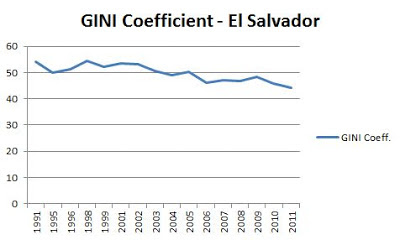Income Inequality in El Salvador
This is the fourth in a series of posts about the statistical view of El Salvador in the recently released 2011 Multiple Purpose Survey of Households. Today we look at income inequality in El Salvador, that is, how wide is the disparity between rich and poor when it comes to incomes in El Salvador.
One statistic used by demographers to represent income inequality is the Gini coefficient.
Wikipedia explains the Gini coefficient here:
The 2011 Salvadoran households survey reports that the GINI coefficient is declining. Here is a graph with the scores over the past two decades:
Wikipedia explains the Gini coefficient here:
The Gini coefficient measures the inequality among values of a frequency distribution (for example levels of income). A Gini coefficient of zero expresses perfect equality where all values are the same (for example, where everyone has an exactly equal income). A Gini coefficient of one (100 on the percentile scale) expresses maximal inequality among values (for example where only one person has all the income)....
According to UNICEF, Latin America and the Caribbean region had the highest net income Gini index in the world at 48.3, on unweighted average basis in 2008. The remaining regional averages were: sub-Saharan Africa (44.2), Asia (40.4), Middle East and North Africa (39.2), Eastern Europe and Central Asia (35.4), and High-income Countries (30.9). Using the same method, the United States is claimed to have a Gini index of 36, while South Africa the highest income Gini index score of 67.8There's a map of worldwide Gini scores here.
The 2011 Salvadoran households survey reports that the GINI coefficient is declining. Here is a graph with the scores over the past two decades:
As you can see, this statistic for income inequality has been fluctuating between 44 and 48 for the last seven years, which was a decline from higher levels of inequality prevailing before 2002. El Salvador's scores still remain consistent with the rest of Latin America which as a region has some of the highest income inequality in the world.
The way to reduce such income inequality is to find ways to lift people out of poverty with education and opportunity and to grow the country's middle class.

Comments